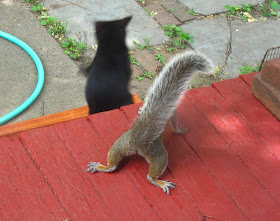
Oh man, it was COLD this morning! When I stepped out on my porch to pick up the papers, my breath caught in my throat from the cold. Or maybe it was because of this strange pink vertical cloud that appeared in the dawn sky. Whether a cloud, a smoke plume or a contrail, I hoped it was a good omen for the walk I had agreed to lead today for my friends in the Thursday Naturalists at Moreau Lake State Park.
I actually wondered if the walk would be canceled because of the cold, but I should never forget what a dedicated bunch this is. Ten hearty souls showed up right on time and well bundled up for our trek across the frozen lake and then a climb up a mountain to visit some porcupine caves.
We crossed the lake to the warming hut, then accessed the Red Oak Ridge Trail that took us about halfway up the mountain, where we turned off on a spur that led us to an area of marble boulders riddled with caves.
It's here in these caves that a population of porcupines make their homes, as evidenced by the well trodden trails that lead from the dens to a grove of hemlock trees.
As their trough-like trails reveal, porcupines don't waste their energy wandering all over the woods looking for food, but make a daily bee-line to their favorite hemlock, where they will return again and again until the tree is so depleted of bark there is nothing left for porky to feed on. It was obvious that many of the hemlocks up on this ridge had been well-pruned by porkies feeding on them.
The trails we found today had been refreshed with a new layer of snow, so we did not find the quills and hairs, nor the porky pee and poop that usually litter the trails. Many of today's group had visited this same spot almost exactly two years ago and remembered well the sign we found then, which I recorded in my blog post for January 31, 2013, which can be revisited HERE. That older post also provides a link to where you can hear the gruntings of porcupines down in their dens. In all the years I've been visiting these caves, I have yet to lay my eyes on a porcupine either on the trail or in a tree. But they certainly leave lots of sign to prove that they are here.



















































